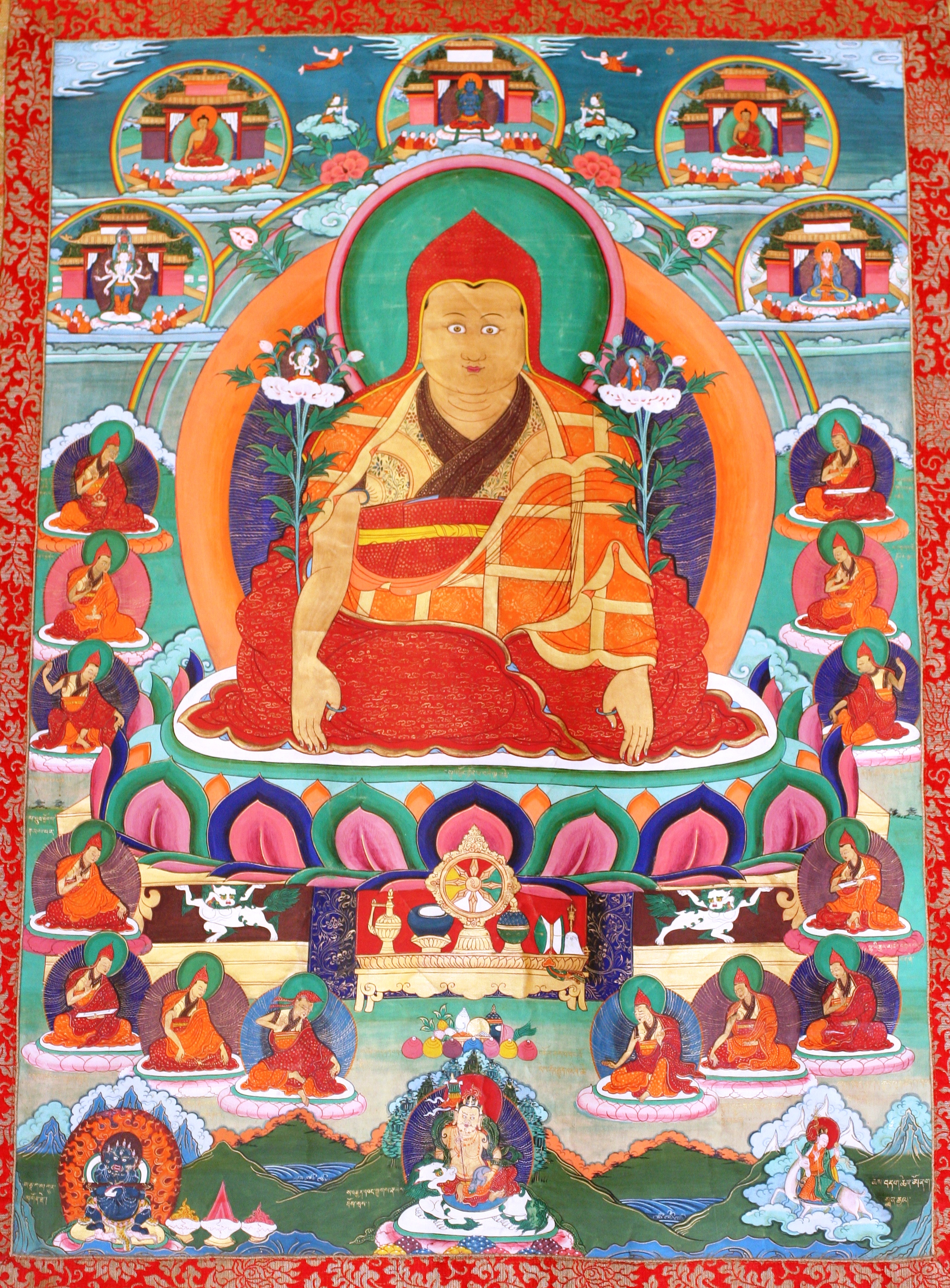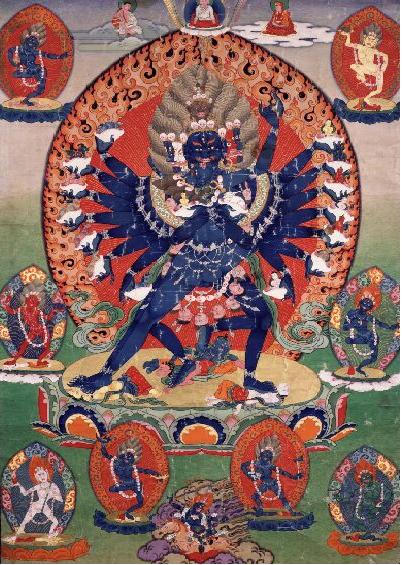|
Kagyud
The ''Kagyu'' school, also transliterated as ''Kagyü'', or ''Kagyud'' (), which translates to "Oral Lineage" or "Whispered Transmission" school, is one of the main schools (''chos lugs'') of Tibetan (or Himalayan) Buddhism. The Kagyu lineages trace themselves back to the 11th century Indian Mahasiddhas Naropa, Maitripa and the yogini Niguma, via their student Marpa Lotsawa (1012–1097), who brought their teachings to Tibet. Marpa's student Milarepa was also an influential poet and teacher. The Tibetan Kagyu tradition gave rise to a large number of independent sub-schools and lineages. The principal Kagyu lineages existing today as independent schools are those which stem from Milarepa's disciple, Gampopa (1079–1153), a monk who merged the Kagyu lineage with the Kadam tradition. The Kagyu schools which survive as independent institutions are mainly the Karma Kagyu, Drikung Kagyu, Drukpa Lineage and the Taklung Kagyu. The Karma Kagyu school is the largest of the sub-school ... [...More Info...] [...Related Items...] OR: [Wikipedia] [Google] [Baidu] |
Jonang
The Jonang () is one of the schools of Tibetan Buddhism. Its origins in Tibet can be traced to early 12th century master Yumo Mikyo Dorje, but became much wider known with the help of Dolpopa Sherab Gyaltsen, a monk originally trained in the Sakya school. The Jonang school’s main practice comes from the Kalachakra cycle. The Jonang re-established their religio-political center in Golok, Nakhi and Mongol areas of Kham and Amdo with the school's seat () at Dzamtang Tsangwa () dzong and have continued practicing uninterrupted to this day. An estimated 5,000 monks and nuns of the Jonang tradition practice today in these areas. However, their teachings were limited to these regions until the Rimé movement of the 19th century encouraged the study of non-Gelug schools of thought and practice.Gruschke 2001, p.72 History The monk Künpang Tukjé Tsöndrü (, 1243–1313) established a kumbum or stupa-vihara in the Jomonang Valley about northwest of the Tashilhunpo Monastery in Ü ... [...More Info...] [...Related Items...] OR: [Wikipedia] [Google] [Baidu] |
Drukpa Lineage
The Drukpa Kagyu (), or simply Drukpa, sometimes called either Dugpa or "Red Hat sect" in older sources,Initiations And Initiates In Tibet, p. 34 by . lineage is a branch of the Kagyu school of . The Kagyu school is one of the ... [...More Info...] [...Related Items...] OR: [Wikipedia] [Google] [Baidu] |
Shangpa Kagyu
The Shangpa Kagyu (, "Oral Tradition of the man from Shang") is known as the "secret lineage" of the Kagyu school of Vajrayana or Tibetan Buddhism and differs in origin from the better known Dagpo Kagyu schools. The Dagpo Kagyu are the lineage of Tilopa through his student Naropa, often traced through Naropa's famous student Marpa Lotsawa and thus called "Marpa Kagyu", while the Shangpa lineage descends from Tilopa's student Niguma, who was Naropa's sister, as well as from the teachings of Sukhasiddhi. Its founder was Khyungpo Naljor, the student of both women, whose monastery in the Shang Valley gave its name to the tradition. The principal Shangpa dharmapala is the six-armed Mahākāla. The Shangpa tradition was revitalized in the 20th century by the first Kalu Rinpoche, who had many students both in Tibet and in the West. Origins The Shangpa Kagyu lineage was founded by the eleventh-century Tibetan scholar Khyungpo Naljor. Seeking to increase his understanding of th ... [...More Info...] [...Related Items...] OR: [Wikipedia] [Google] [Baidu] |
Naropa
Nāropā (Prakrit; sa, Nāropāda, Naḍapāda or Abhayakirti) or Abhayakirti was an Indian Buddhist Mahasiddha. He was the disciple of Tilopa and brother, or some sources say partner and pupil, of Niguma. As an Indian Mahasiddha, Naropa's instructions inform Vajrayana, particularly his six yogas of Naropa relevant to the completion stage of anuttarayogatantra. He was also one of the gatekeepers of Vikramashila monastery which is located in Bihar. Although some accounts relate that Naropa was the personal teacher of Marpa Lotsawa, other accounts suggest that Marpa held Naropa's lineage through intermediary disciples only. Names According to scholar John Newman, "the Tibetans give Nāro's name as ''Nā ro pa, Nā ro paṇ chen, Nā ro ta pa,'' and so forth. The manuscript of the ''Paramarthasaṃgraha'' preserves a Sanskrit form ''Naḍapāda'' (''Paramarthasaṃgraha'' 74). A Sanskrit manuscript edited by Tucci preserves an apparent Prakrit form ''Nāropā'', as well as a ... [...More Info...] [...Related Items...] OR: [Wikipedia] [Google] [Baidu] |
Atiśa
( bn, অতীশ দীপংকর শ্রীজ্ঞান, ôtiś dīpôṅkôr śrigyen; 982–1054) was a Buddhist religious leader and master. He is generally associated with his work carried out at the Vikramashila monastery in Bihar. He was one of the major figures in the spread of 11th-century Mahayana and Vajrayana Buddhism in Asia and inspired Buddhist thought from Tibet to Sumatra. He is recognised as one of the greatest figures of medieval Buddhism. Atiśa's chief disciple, Dromtön, was the founder of the Kadam school, one of the New Translation schools of Tibetan Buddhism, later supplanted by the Gelug tradition in the 14th century which adopted its teachings and absorbed its monasteries. In 2004, Atiśa was ranked 18th in the BBC's poll of the greatest Bengalis of all time. Early life Palace life Bikrampur, the most probable place for Atiśa's birthplace, was the capital of the Pala Empire as it was of the ancient kingdoms of southeast Bengal. Though ... [...More Info...] [...Related Items...] OR: [Wikipedia] [Google] [Baidu] |
Hevajra
Hevajra (Tibetan: kye'i rdo rje / kye rdo rje; Chinese: 喜金剛 Xǐ jīngāng / 呼金剛 Hū jīngāng;) is one of the main yidams (enlightened beings) in Tantric, or Vajrayana Buddhism. Hevajra's consort is Nairātmyā (Tibetan: bdag med ma). History India The Hevajra Tantra, a yoginītantra of the ''anuttarayogatantra'' class, is believed to have originated between the late 8th (Snellgrove), and the late 9th or early 10th centuries (Davidson), in Eastern India, possibly Kamarupa. Tāranātha lists Saroruha and Kampala (also known as "Lva-va-pā", "Kambhalī", and "Śrī-prabhada") as its "bringers": .. the foremost yogi Virupa meditated on the path of Yamāri and attained siddhi under the blessings of Vajravārāhi,...His disciple Dombi Heruka..understood the essence of the Hevajra Tantra, and composed many śāstras like the ''Nairātmā-devi-sādhana'' and the ''Sahaja-siddhi''. He also conferred abhiṣeka on his own disciples. After this, two ācāryas Lva-v ... [...More Info...] [...Related Items...] OR: [Wikipedia] [Google] [Baidu] |
Cakrasaṃvara Tantra
The ''Cakrasaṃvara Tantra'' (, ''khorlo demchok,'' The "Binding of the Wheels" Tantra) is an influential Buddhist Tantra. It is roughly dated to the late eight or early ninth century by David B. Gray (with a ''terminus ante quem'' in the late tenth century). The full title in the Sanskrit manuscript used by Gray's translation is: ''Great King of Yoginī Tantras called the Śrī Cakrasaṃvara'' (''Śrīcakrasaṃvara-nāma-mahayoginī-tantra-rāja''). The text is also called the ''Discourse of Śrī Heruka'' (''Śrīherukābhidhāna'') and the ''Samvara Light'' (''Laghusaṃvara''). "Cakrasaṃvara" may also refer to the main deity in this tantra as well as to a collection of texts or "cycle" associated with the root Cakrasaṃvara tantra. Tsunehiko Sugiki writes that this "Cakrasaṃvara cycle", "is one of the largest collections of Buddhist Yoginītantra literature from the early medieval South Asian world."Sugiki, Tsunehiko. Review of ''David B. Gray, The Cakrasamvara Tantra ... [...More Info...] [...Related Items...] OR: [Wikipedia] [Google] [Baidu] |
Kukkuripa
Early life Kukkuripa was a mahasiddha who lived in India. He became interested in tantric Buddhist practice, and chose the path of renunciation. During his travels, he found a starving dog in a bush. Moved by compassion, he fed the dog and took care of her. The two stayed together and eventually found a cave where Kukkuripa could meditate in peace. When he went out for food, the dog would stay and guard the cave. One day, after 12 years passed, the stories say that the gods of the Thirty-three sensual heavens took note of Kukkuripa's accomplishments, and invited him to their heavens. He accepted, and while there he was given many pleasureable things, such as great feasts. Every time he would think of his loyal dog, left behind at the cave, he would begin to think that he should return to her, but every time they would convince him to stay. Eventually, he looked down from the heavens and saw that his dog had become thin, sad, and hungry, and right there he decided that he would ... [...More Info...] [...Related Items...] OR: [Wikipedia] [Google] [Baidu] |
Saraha
Saraha, Sarahapa, Sarahapāda (or, in the Tibetan language མདའ་བསྣུན་, anün Wyl. mda' bsnun The Archer), (''circa'' 8th century CE) was known as the first sahajiya and one of the Mahasiddhas. The name ''Saraha'' means "the one who has shot the arrow.". According to one, scholar, "This is an explicit reference to an incident in many versions of his biography when he studied with a dakini disguised as a low-caste arrow smith. Metaphorically, it refers to one who has shot the arrow of non duality into the heart of duality." Saraha is considered to be one of the founders of Vajrayana Buddhism, particularly the Mahāmudrā tradition. Saraha was originally known as Rāhula or Rāhulbhadra and was born in Roli, a region of the city-state of Rajni in eastern India, into a Shakya family and studied at the Buddhist monastic university Nalanda. The Arrow Making Dakini Saraha is normally shown seated and holding an arrow (Skt. śaru). It is from a mature nameles ... [...More Info...] [...Related Items...] OR: [Wikipedia] [Google] [Baidu] |
Indrabhuti
Indrabhuti (alternatively King Ja) is a name attributed to a number of individuals that have become conflated in Vajrayana Buddhism. One Indrabhuti, considered a Mahasiddha, was a disciple of Lawapa. Identities of the king Samten Karmay attempted to identify the different personages known as Indrabhutai. Conflation of Indrabhuti related to conflation of Oddiyana The matter of the conflation of Indrabhuti and at least one evocation of the historicity of a particular personage by that name is intimately connected with the location of 'Oddiyana' (the locality denoted by the term 'Oddiyana' whether in each case cited is Swat Valley or Odisha or some other location is glossed with a suite of orthographic representations and near homophones which require further case-by-case examination and exploration), Odisha and the cult of Jaganath and a number of texts that inform the matter such as the '' Sādhanamālā'', '' Kālikā Purāṇa'', ''Caturāsiti-siddha-Pravṛtti'', '' Jñānasidd ... [...More Info...] [...Related Items...] OR: [Wikipedia] [Google] [Baidu] |
Nagarjuna
Nāgārjuna . 150 – c. 250 CE (disputed)was an Indian Mahāyāna Buddhist thinker, scholar-saint and philosopher. He is widely considered one of the most important Buddhist philosophers.Garfield, Jay L. (1995), ''The Fundamental Wisdom of the Middle Way'', Oxford: Oxford University Press. Jan Westerhoff considers him to be "one of the greatest thinkers in the history of Asian philosophy." Nāgārjuna is widely considered to be the founder of the Madhyamaka (centrism, middle-way) school of Buddhist philosophy and a defender of the Mahāyāna movement. His ''Mūlamadhyamakakārikā'' (Root Verses on Madhyamaka, or MMK) is the most important text on the madhyamaka philosophy of emptiness. The MMK inspired a large number of commentaries in Sanskrit, Chinese, Tibetan, Korean and Japanese and continues to be studied today. History Background India in the first and second centuries CE was politically divided into various states, including the Kushan Empire and the Satavaha ... [...More Info...] [...Related Items...] OR: [Wikipedia] [Google] [Baidu] |






.jpg)

